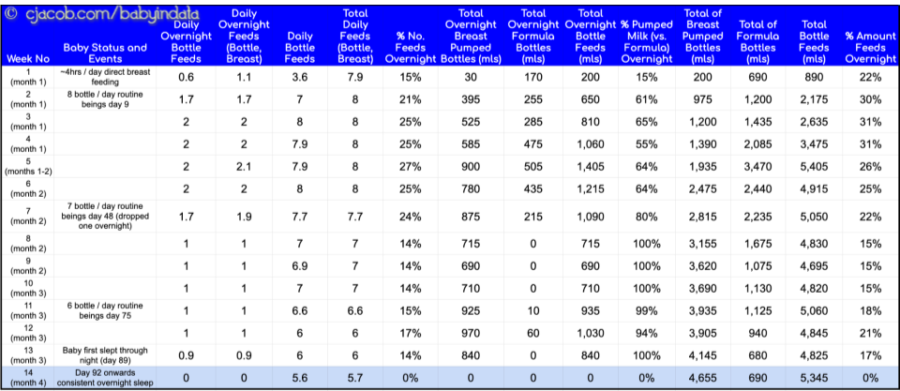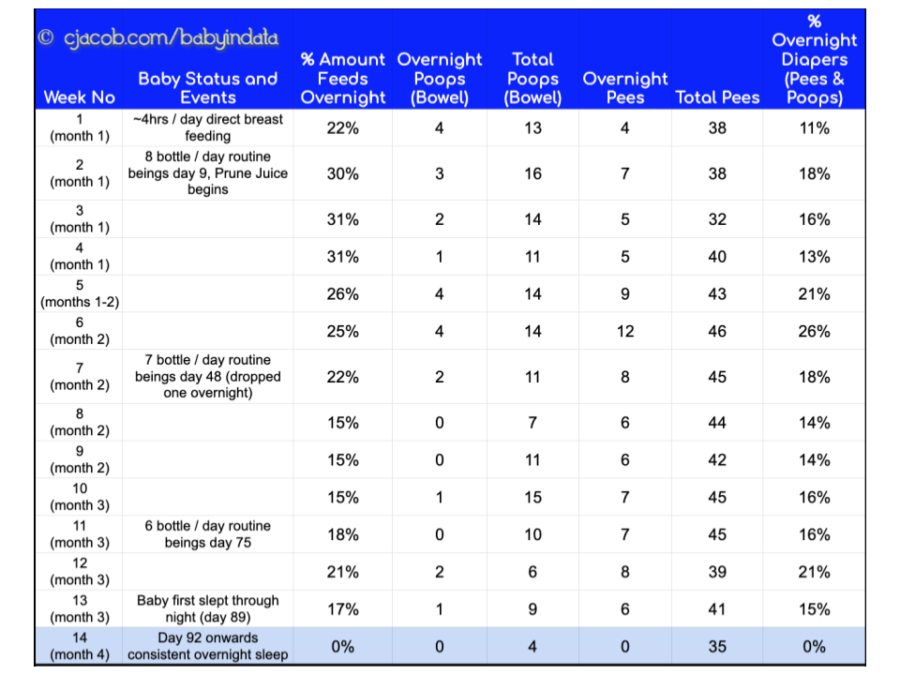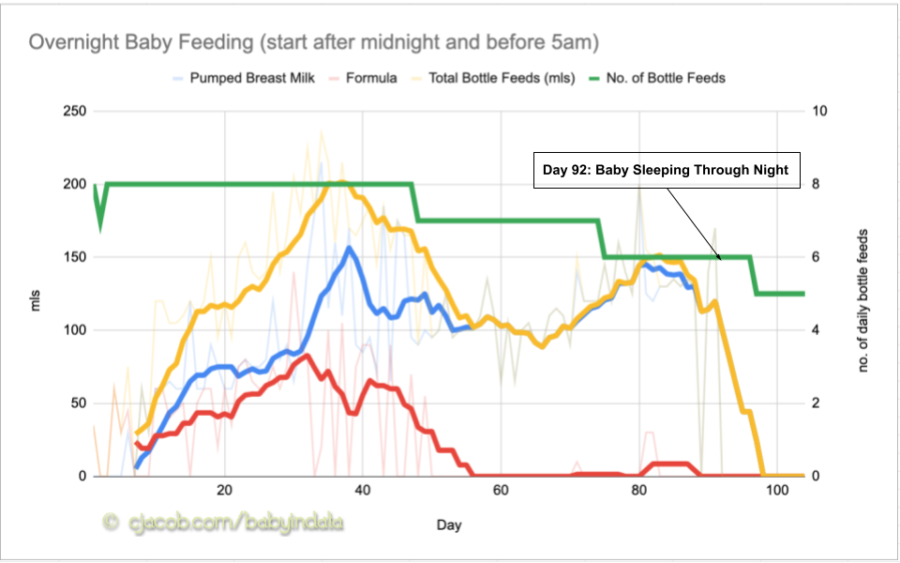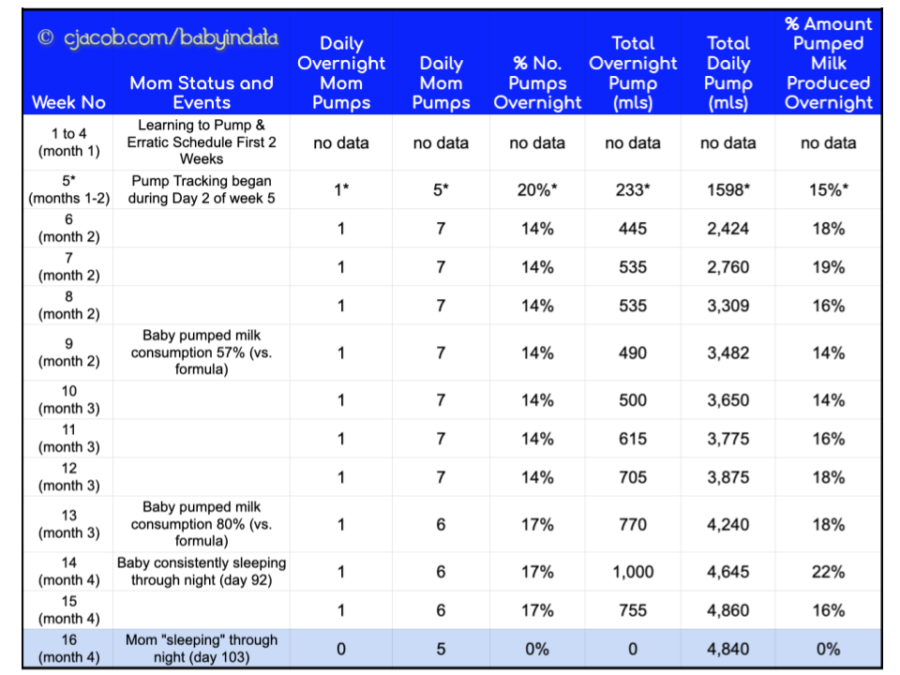Whether you are a new or seasoned parent, one of the common near-term goals is how quickly you can get to the nights when your baby (mostly) can comfortably sleep through the night. In theory, this means that you, as parents, can get more sleep. However, as most parents know that due to things like pumping milk, concern about your baby’s well being, worry over the possibility of SIDs, over tiredness, work, house chores, etc., this may not be the case.
However, it is a point of pride in your baby and self satisfaction with yourselves as parents if/when you reach this point, along with empathy for others who may take longer or are struggling for whatever reason. Before we go into this more, I encourage you to read our A Baby Feeding Journey over 14 Months (a 12 Part Series) to give you an overview of baby in data focus and the intent behind it.
I will also say that this will not be a tip post about how to get your baby to sleep through the night, beyond talking about we did it. Whether what we point out was what actually got our baby to sleep through the night, let alone whether it may work for your child, of course will not be 100% certain. This is really talking about the data behind it and how we got there, and hopefully will give you some benchmarks and trends for you to compare to in your getting your own baby to sleep through the night in your early parenting journey.
We define “overnight feeding” as the period between midnight to 5am because this was key to getting us “sleeping through the night” in theory. Everyone could define this differently, but the reason we did this is a combination of when our night nurse would arrive around 10pm, the pumping schedule at the time where there was initially an 11pm pump session, and that once we were up after 5am, there was not an “overnight sleep feel” anymore for us vs. just shorter naps.
Table 1: Baby Overnight Feeding Weekly View (First 14 Weeks or ~100 Days)

Table 2: Baby Overnight Diaper Weekly View (First 14 Weeks or ~100 Days)

Chart 1: Baby Overnight Feeding Breast Milk & Formula vs. No. of Feeds (7-day moving average)

Some Highlights:
- From a data perspective, it took literally 3 months, as period from Day 1 to Day 92 for us to stop some type of overnight feeding regime for our baby. So on March 16, at just over 3 months of age, our baby began sleeping through the night, originally with her last feed of the day around 10pm, and then a first morning feed at around 6am. So for us, this was about a 7-8 hour sleep period (note: our dataset, as explained in the overview, starts at day 6 of baby’s life).
- So what were the various milestones for us?
- From the beginning we had two overnight cycles as part of the “feed/change diaper every 3 hour” routine (often it was at 1am and 4am). Given this was late December and January in the northern hemisphere, it was quite bleak outside.
- If you look at Number of Baby Feeds per Day in Year 1, you will see that during months 1-3, we fed our child 12x (month 1), 11x (month 2), and 9x (month 3), respectively. You will also note our early struggles with direct breast feeding/nursing, further documented here: A 1+ Year Breast Pumping Journey in Data. So by half way through month 2 (day 48), we were down to one overnight feed (this was 48 days in our dataset, or technically 53 days of life as described in our overview).
- Then just after month 3 (March 16), this last overnight feed was eliminated, which was a further 43 days later from Jan 31.
- If you are keeping count, she slept through the night consistently from day 92 of our data set (or technically day 97 of life) or from about 3 months onward.
- Interestingly, baby sleeping through the night slightly pre-dated the data trend as it related it to number of feeds, as it was only the Day 95-97 period when she went down to 5 bottle feeds per day permanently, which helped this sleep-through-the-night transition.
- Her average bottle in month 4 (day 91 onwards) was 153 mls (5.2 oz), which was when she was sleeping through the night, for all but day 1. This amount was 40% higher than during month 3 at 109 mls (3.7 oz), so a dramatic increase in food consumed per feeding session helped.
- As discussed in Baby’s First Year of Diapers (all the pee & poops), there was a dramatic drop off in pooping in month 4 vs. month 3 of 39% less poops, even though only 6% fewer diaper changes. So potentially, this also helped the transition as well.
- Interestingly, she did sleep through the night on Day 89 (so 3 days before she started doing it consistently) as well.
- If you read our thoughts and view the table and charts in our Baby Feeding by Time of Day in Year 1 you will see a time of day view on feeding for the first 3 months. Now if we go one level deeper into this data, you will see:
- During month 1, ~30% of daily bottle feeds consumed were in the overnight hours. If you just do simple math, assuming feeds every 3 hours, and our two overnight feeds during this period, you would assume ~25% to be the average rate consumed overnight, as a quarter of the daily feeds
- Now by month 2, when the baby was feeding on more of a routine, she consumed 8 bottle feeds per day for the first half of month, and down to 7 bottle feeds for second half of the month (and one overnight feed as noted earlier), only 16% of daily bottle feeds consumed were in the overnight hours.
- This actually rose in month 3 to 18% of daily bottle feeds consumed overnight, as baby went down to 6 feeds per day but larger amount consumed per day as documented in 14 Months of Feeding a Baby in Data.
- Finally, we had this general idea as noted in the Baby Feeding by Time of Day in Year 1 to try and feed her more (pumped) breast milk in first part of day, including overnight. This became easier over time as pumping/expressed breast milk output increased, and we dropped this to one overnight feed.
- In the month 1 period, she usually had one breast milk bottle for one feed and then one formula bottle for another feed for overnight feeds.
- In the first half of month 2 (day 32 onwards), there were quite a few days when only pumped breast milk or certainly the majority of overnight consumption was breast milk. 73% of bottles consumed overnight were breast milk (vs. formula) during this first half of month 2 vs. 56% breast milk (vs. formula) in the month 1 period.
- So after baby dropped to one overnight feed on Day 48, there were only four nights at this point onward when she had any formula, and three of those were “top ups” to when she was mostly drinking breast milk. In this period, 98% of her overnight feeds were breast milk (vs. formula).
Table 3: Mom Overnight Pumping Weekly View (First 16 Weeks or ~110 Days)

Some Highlights (see full mom’s pumping journey data in depth):
- (As discussed in main pumping post, we didn’t start properly tracking pumps until day 30, which was in week 5; this whole dataset starts at day 6 of baby’s life as discussed in overview).
- You can see during this entire period, there was a rapid increase in overall pumped/expressed breast milk output, including during the overnight period, with a 2-3x increase between week 5 and week 16.
- The proportion of breast milk expressed/pumped overnight ranged between 14-22% during these early weeks, with an actual general trend increase from weeks 11 to 16 (week 13 dropped to 6 pumps per day).
- Many expert pumping sources like Exclusive Pumping report that the early morning to morning hours were pumping mothers’ highest expressed breast milk output times of day.
- You can see at week 16, on day 103, mom dropped to 5 pumps per days and stopped pumping “overnight” to now have the potential ability to sleep through the night.
Final Thoughts:
Overall from our data perspective, you can potentially see some indicators as to when your child could be ready to seem to be ready to sleep through the night;
- When she is transitioning from 6 to 5 feeds per day could be a good indicator.
- When the average bottle consumption increases dramatically and is around 150 mls (5 oz) per bottle.
- When her poop diapers stabilize or decline, allowing for longer and comfortable sleep.
- When she drops from needing 2 overnight feeds to 1 overnight feed, you might be at the halfway mark.
- If pumping is part of your chosen feeding journey, as much as you can, invest some time in learning how to use your specific breast pump, ideal breast pump settings, and flange fitting. Develop a repeatable routine for setup, organizing, and cleaning, as well, for your own sanity. If exclusively pumping, create a schedule for when you aim to start dropping pumps with a short-term goal to drop your overnight pump sessions, as well, to allow for a potential full night’s sleep.
However, all this is based on a sample size of one and are very general guidelines to give you a vague benchmark in what is a very unique process for each child. Good luck!
